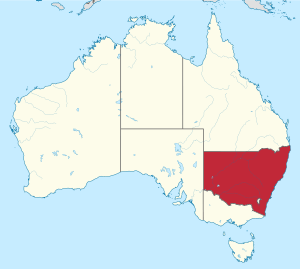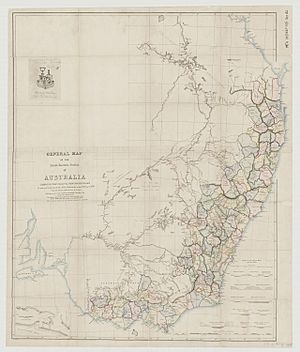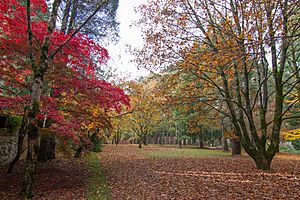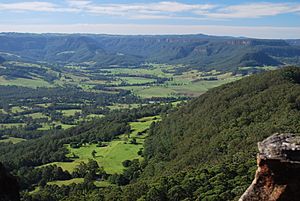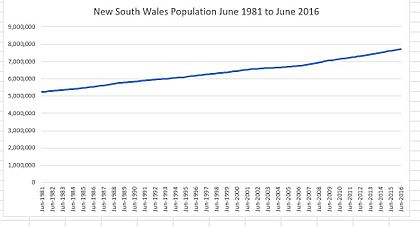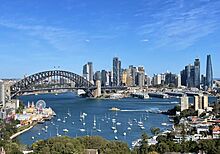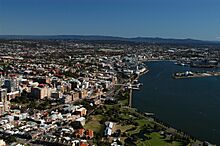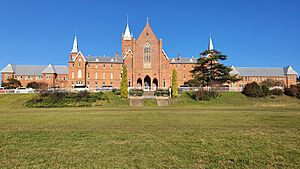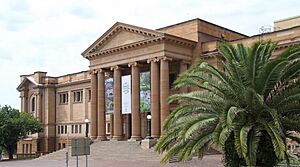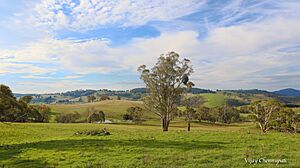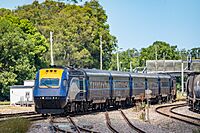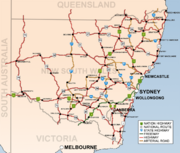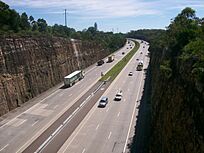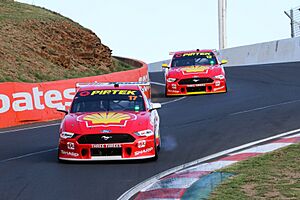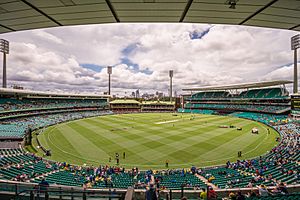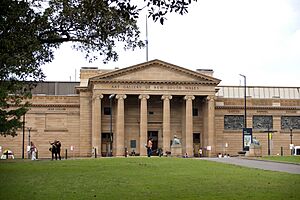New South Wales facts for kids
Quick facts for kids
New South Wales
|
|||
|---|---|---|---|
|
|||
Nickname(s):
|
|||
| Motto: | |||
|
Location of New South Wales in Australia
Coordinates: 32°S 147°E / 32°S 147°E |
|||
| Country | Australia | ||
| Before federation | Colony of New South Wales | ||
| Establishment | 26 January 1788 | ||
| Responsible government | 6 June 1856 | ||
| Federation | 1 January 1901 | ||
| Capital
and largest city
|
Sydney 33°52′04″S 151°12′36″E / 33.86778°S 151.21000°E |
||
| Administration | 128 local government areas | ||
| Demonym(s) | New South Welshmen | ||
| Government | |||
|
• Monarch
|
Charles III | ||
|
• Governor
|
Margaret Beazley | ||
|
• Premier
|
Chris Minns (ALP) | ||
| Legislature | Parliament of New South Wales | ||
| Legislative Council | |||
| Legislative Assembly | |||
| Parliament of Australia | |||
|
• Senate
|
12 senators (of 76) | ||
| 47 seats (of 151) | |||
| Area | |||
|
• Land
|
801,150 km2 (309,330 sq mi) | ||
| Highest elevation | 2,228 m (7,310 ft) | ||
| Population | |||
|
• Estimate
|
|||
|
• Density
|
10.15/km2 (26.3/sq mi) (3rd) | ||
| GDP (nominal) | 2020 estimate | ||
|
• Total
|
|||
|
• Per capita
|
|||
| HDI (2021) | very high · 3rd |
||
| Time zone |
|
||
|
• Summer (DST)
|
|||
| Postal abbreviation |
NSW
|
||
| ISO 3166 code | AU-NSW | ||
| Symbols | |||
| Mammal | Platypus (Ornithorhynchus anatinus) |
||
| Bird | Kookaburra (Dacelo gigas) |
||
| Fish | Blue groper (Achoerodus viridis) |
||
| Flower | Waratah (Telopea speciosissima) |
||
| Fossil | Mandageria fairfaxi | ||
| Mineral | Black opal | ||
| Colour | Sky blue (Pantone 291) |
||
New South Wales (often called NSW) is a state on the east coast of Australia. It shares borders with Queensland to the north, Victoria to the south, and South Australia to the west. Its eastern coast touches the Coral and Tasman Seas. The Australian Capital Territory and Jervis Bay Territory are special areas completely surrounded by New South Wales.
Sydney is the capital city of New South Wales. It is also Australia's largest city. In December 2023, New South Wales had over 8.3 million people. This makes it Australia's most populated state. About two-thirds of the state's people, 5.3 million, live in the greater Sydney area.
The Colony of New South Wales was started by Britain in 1788. It was a "penal colony," meaning it was a place where criminals were sent as punishment. Originally, it covered more than half of the Australian mainland. Over time, parts of it became separate British colonies. These colonies later became the different states and territories of Australia. Lord Howe Island is still part of New South Wales.
Contents
History of New South Wales
First People of New South Wales
The first people to live in New South Wales were the Aboriginal Australians. They arrived in Australia about 40,000 to 60,000 years ago. Before Europeans arrived, there were an estimated 250,000 Aboriginal people in this region.
Many different Aboriginal groups lived on these lands. The Wodiwodi people, who spoke a language called Dharawal, lived south of Sydney. The Bundjalung people were the traditional owners of parts of the northern coastal areas. Other groups included the Wiradjuri, Gamilaray, Yuin, Ngarigo, Gweagal, and Ngiyampaa peoples.
British Settlement in 1788
In 1770, James Cook mapped the eastern coast of Australia. He claimed this land for Britain and first called it New Wales. Later, he changed the name to New South Wales.
In January 1788, Arthur Phillip arrived in Botany Bay with the First Fleet. This fleet had 11 ships carrying over a thousand settlers, including 736 convicts. Convicts were people sent from Britain as punishment for crimes. A few days later, the fleet moved to Port Jackson. Phillip started a settlement there, which he named Sydney Cove. This happened on 26 January 1788, which is now Australia Day.
Governor Phillip was in charge of a very large area. This area included modern New South Wales, Queensland, Victoria, and Tasmania. He was also thought to have authority over what is now New Zealand. The colony was first meant to be a self-sufficient farm for convicts. But over time, farming and trade grew. By 1803, the colony could grow enough grain for itself.
In 1804, some Irish convicts tried to rebel in the Castle Hill convict rebellion. They wanted to march on Sydney and escape. However, they were stopped by soldiers and volunteers.
Lachlan Macquarie became governor in 1810. He ordered the building of roads, docks, churches, and public buildings. He also sent explorers to map new areas. A road across the Blue Mountains was finished in 1815. This opened up new lands for farming and grazing.
In 1825, Van Diemen's Land (now Tasmania) became a separate colony. The western border of New South Wales was moved further west. New Zealand also became a separate colony in 1841.
From the 1820s, people called "squatters" started farming and raising sheep and cattle on land without permission. This led to conflicts with Aboriginal landowners. By 1844, wool was half of the colony's exports.
The transportation of convicts to New South Wales stopped in 1840. In 1842, a Legislative Council was created. Some of its members were elected. Former convicts could vote, but only men who owned property could.
Growth and Gold in the 1850s to 1890s

In 1856, New South Wales gained "responsible government." This meant it could govern itself more. It set up a parliament with two houses. One house was elected by the people. More men were allowed to vote, and by 1858, all adult men could vote. In 1859, Queensland became a separate colony.
New laws in 1861 encouraged family farms. The amount of land used for farming grew a lot. Wool production also continued to increase. By the 1880s, New South Wales produced almost half of Australia's wool. Coal and gold were also found. These became important exports.
The economy of New South Wales became more varied. More people worked in factories than in any other Australian colony. The government also built many important things like railways, telegraph lines, and roads. By 1889, you could travel by train from Brisbane to Adelaide, passing through Sydney and Melbourne.
Trade unions grew in the 1880s. A big strike in 1890 led to the creation of the Labor party. This party won many seats in the 1891 elections. Women also began to fight for the right to vote. The Womanhood Suffrage League of New South Wales was started in 1891.
Australia Becomes a Nation in 1901
A group called the Federal Council of Australasia was formed in 1885. New South Wales did not join it at first. One big problem was that Victoria had policies that protected its own industries, while New South Wales believed in free trade.
However, the NSW premier, Henry Parkes, strongly supported Australia becoming one nation. His speech in 1889 helped gain support for this idea. He worked with Edmund Barton to make federation happen.
In 1893, the first citizens' Federation League was set up in New South Wales. Many other groups formed. They held a meeting in Corowa in July 1893. This meeting created a plan for federation. The new NSW premier, George Reid, supported this plan.
A meeting in 1897 and 1898 created a proposed constitution for a new "Commonwealth of federated states." But a vote on the constitution failed in New South Wales. The Labor party was against it.
The leaders of the other colonies agreed to some changes for New South Wales. For example, the future capital of Australia would be in NSW. In 1899, more votes were held in all colonies except Western Australia. All of them passed. The British Parliament passed the necessary law in 1900. Western Australia then voted to join. The Commonwealth of Australia officially began on 1 January 1901.
New South Wales: 1901 to 1945
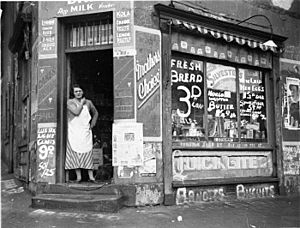
After Australia became a nation, New South Wales governments made many social changes. Women gained the right to vote in NSW elections in 1902. The Labor party came to power in 1910.
When World War I started in 1914, many people from NSW volunteered to fight. In 1916, the NSW premier, William Holman, was removed from the Labor party because he supported forcing people to join the army.
After the war, NSW governments started big public building projects. These included new roads, railways, and the Sydney Harbour Bridge. These projects were paid for with loans. This led to money problems when the Great Depression hit in 1929. New South Wales was hit harder than other states. By 1932, one-third of union members in the state had no jobs.
Jack Lang became premier in 1930. He suggested stopping interest payments to British lenders to help with unemployment. This plan was rejected. Lang's government was later removed from office in 1932.
When World War II started in 1939, people in NSW were not very enthusiastic. But this changed when Japan entered the war in December 1941. In May 1942, Japanese submarines entered Sydney Harbour. They sank a naval ship, killing 29 men. The next month, Japanese warships shelled Sydney and Newcastle. Many American troops arrived in the state. Factories, steelmaking, and shipbuilding grew. Unemployment almost disappeared.
A Labor government led by William McKell was elected in 1941. This government had a good relationship with the federal government. McKell was the first Labor leader to serve a full term and be re-elected. The Labor party governed New South Wales until 1965.
After the War
The Labor government introduced two weeks of paid holidays for most NSW workers in 1944. A 40-hour work week was set by 1947. After the war, the economy boomed. Most people had jobs, and living standards improved. The government spent a lot of money on housing, dams, and electricity.
In 1954, a plan was announced to build an opera house in Sydney. The design by Jørn Utzon was chosen. The high cost and delays in building the Sydney Opera House became a political issue. This was one reason why the Labor government lost power in 1965. The Liberal Party and Country Party coalition, led by Robert Askin, won.
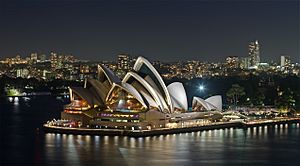
The Askin government encouraged private building projects. They also focused on law and order. In the late 1960s, some people in the New England region wanted to form a new state. A vote was held in 1967, but the idea was narrowly defeated.
After Askin resigned in 1975, several Liberal leaders were premier for short times. In 1976, the Labor party, led by Neville Wran, won the election. Wran became very popular and won big victories in 1978 and 1981.
Wran resigned in 1984. His replacement, Barrie Unsworth, lost the 1988 election to the Liberal Party, led by Nick Greiner. The Greiner government tried to make government services more efficient. They created the Independent Commission Against Corruption (ICAC) to fight corruption.
In 1992, Greiner was investigated by ICAC. He resigned but was later cleared of any wrongdoing. John Fahey became premier. His government narrowly lost the 1995 election to the Labor party, led by Bob Carr. Carr became the longest-serving premier of the state.
The Carr government (1995–2005) continued to focus on good government services like health and transport. They also worked with private companies to build things like freeways and tunnels. The Carr government was popular for successfully hosting big events, especially the 2000 Summer Olympics.
Carr resigned in 2005. Several premiers followed, including Morris Iemma, Nathan Rees, and Kristina Keneally. Keneally became the first female premier of New South Wales. Her government lost in 2011. Barry O'Farrell became premier. He resigned in 2014 and was replaced by Mike Baird. Baird resigned in 2017 and was replaced by Gladys Berejiklian.
Berejiklian led her party to win a third term in 2019. She was popular for how she handled bushfires and the COVID-19 pandemic. However, she resigned in 2021 after ICAC started an investigation into her actions. Dominic Perrottet took her place.
Geography of New South Wales
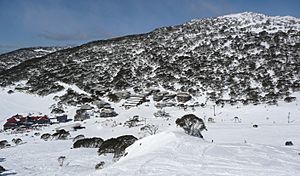
New South Wales is bordered by Queensland to the north, South Australia to the west, and Victoria to the south. To the east are the Coral and Tasman Seas. The Australian Capital Territory and Jervis Bay Territory are special areas completely surrounded by New South Wales.
The state has four main geographic areas. New South Wales' three biggest cities – Sydney, Newcastle, and Wollongong – are on a narrow coastal strip. This strip goes from cool areas in the south to warmer, subtropical areas near Queensland.
The Illawarra region is around Wollongong. Further south are the Shoalhaven and Sapphire Coasts. The Central Coast is between Sydney and Newcastle. North of that are the Mid North Coast and Northern Rivers regions. Tourism is important in coastal towns like Coffs Harbour and Port Macquarie. These areas also produce seafood, beef, fruit, and timber.
The Great Dividing Range is a mountain range that runs through New South Wales. It includes the Snowy Mountains, where Mount Kosciuszko, Australia's highest peak (2229 meters), is located. Skiing in Australia started here around 1861. Farming, especially wool, is important in the highlands. Major towns include Armidale, Bathurst, and Tamworth.
New South Wales has many forests with trees like Red Gum Eucalyptus. The forest floors have many shrubs and fungi.
The western slopes and plains make up a large part of the state. They have fewer people than the coastal areas. Farming is key to the economy here, especially in the Riverina region. Cities like Albury, Dubbo, and Wagga Wagga serve these farming areas. The western plains are mostly dry or semi-dry. The mining town of Broken Hill is the largest town in this area.
Climate in New South Wales

More than half of New South Wales has a dry or semi-dry climate. Rainfall is low, usually between 150 to 500 mm a year. Summers can be very hot, and winter nights can be quite cold. Rainfall varies across the state. The far north-west gets the least rain, while the east gets between 700 and 1400 mm.
The climate along the coast is generally mild. It ranges from oceanic in the south to humid subtropical in the north. This area gets the most rain, sometimes up to 3000 mm in places like Dorrigo. In the south, rain is heaviest in winter. In the north, rain is heaviest in summer due to tropical weather systems.
The southern half of the state has warm to hot summers and cool winters. The seasons are clearer as you move inland. The northeast region, or North Coast, is hot and humid in summer and mild in winter. The Northern Tablelands have mild summers and cold winters because they are high up in the Great Dividing Range.
Snowfall is common in the higher parts of the Great Dividing Range. Temperatures can be cold in winter with lots of frost and snow. Summers are rarely hot due to the high elevation. The Blue Mountains have mild to warm summers and cold winters.
The highest temperature ever recorded in New South Wales was 49.7°C at Menindee in 1939. The lowest was -23°C at Charlotte Pass in the Snowy Mountains in 1994. This is also the lowest temperature recorded in all of Australia (not including Antarctica).
People of New South Wales
In December 2021, New South Wales had 8,095,430 people. This is about 31.42% of Australia's total population. In June 2017, almost two-thirds (65.3%) of the NSW population lived in Sydney.
Major Cities and Towns
New South Wales has many important cities and towns. Sydney is the largest. Other major cities include Newcastle and Wollongong. These cities are important centers for living and working.
Background and Immigration
| Birthplace | Population |
|---|---|
| 5,277,497 | |
| 247,595 | |
| 231,385 | |
| 208,962 | |
| 118,527 | |
| 106,930 | |
| 97,995 | |
| 64,946 | |
| 63,293 | |
| 55,353 | |
| 53,046 | |
| 42,347 |
In 2021, the most common backgrounds people identified with were English (29.8%) and Australian (28.6%). Many people in New South Wales were born overseas. In 2021, 2,794,666 people living in NSW were born in other countries. This is 34.6% of the population.
About 3.4% of the population, or 278,043 people, identified as Indigenous Australians in 2021.
Languages Spoken
In 2021, 29.5% of people in New South Wales spoke a language other than English at home. The most popular languages were Mandarin (3.4%), Arabic (2.8%), and Cantonese (1.8%).
Religions
In 2021, the most common religions were Roman Catholicism (22.4%) and Anglicanism (11.9%). About 32.8% of the population said they had no religion.
Education in New South Wales
Primary and Secondary Schools
The school system in New South Wales goes from Kindergarten to Year 12. Primary school is from Kindergarten to Year 6. Secondary school is from Year 7 to Year 12. School is required from before age 6 until age 17 (unless Year 10 is finished earlier).
Schools include government schools and non-government schools. Government schools can be comprehensive or selective. Non-government schools include Catholic schools and other independent schools.
Primary schools usually teach up to Year 6. Secondary schools, often called "high schools," teach from Years 7 to 12. Some "secondary colleges" only teach Years 11 and 12.
The New South Wales Education Standards Authority divides the 13 years of schooling into six stages. These start with Early Stage 1 (Kindergarten) and end with Stage 6 (Years 11 and 12).
Record of School Achievement
The Record of School Achievement (RoSA) is given to students who finish at least Year 10. They get this if they leave school before finishing the Higher School Certificate. The RoSA replaced the old School Certificate in 2012.
Higher School Certificate
The Higher School Certificate (HSC) is the main Year 12 leaving certificate in NSW. It is very popular, with over 75,000 students taking HSC courses in 2022. Most students complete the HSC before going to work or to university. The HSC is needed to get an Australian Tertiary Admission Rank (ATAR). This rank shows how a student compares to others who finished the HSC.
Universities and Colleges
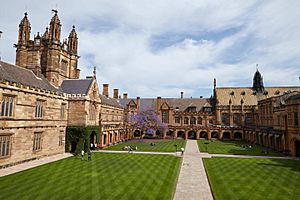
New South Wales has eleven universities. The University of Sydney is Australia's oldest university, founded in 1850. Other universities in Sydney include the University of New South Wales and Macquarie University.
Outside Sydney, important universities are the University of Newcastle and the University of Wollongong. Armidale is home to the University of New England. Charles Sturt University has campuses in different towns.
Public universities are run by the state government. However, the federal government also helps fund and regulate them. Getting into NSW universities is handled by the Universities Admission Centre.
Vocational training is offered by the state government's ten Technical and Further Education (TAFE) institutes. These institutes offer courses at 138 campuses across the state.
Economy of New South Wales

New South Wales has the largest economy of all Australian states. Service industries make up almost 80% of its economic activity. They also provide 90% of jobs. Business services, like financial services and technology, make up nearly a third of the state's economy.
Major exports include coal, copper, beef, and aluminum. Recently, exports of education, tourism, and financial services have grown a lot.
Construction made up 8% of the NSW economy in 2020-21. Manufacturing contributed 6%, mining 2%, and farming less than 2%.
Coal and related products are the state's biggest export. They are worth over A$5 billion to the economy. Tourism is also very important, bringing in over $18.1 billion and employing 3.1% of the workforce.
Farming and Agriculture
Farming makes up just under 2% of the NSW economy. New South Wales has the second-highest value of farm production among Australian states. Wheat is the most widely grown crop. It makes up 39% of Australia's wheat harvest. The most important wheat-growing areas are the Central West and Riverina.
Barley, cotton, and canola are also important crops. Most cotton is grown in the New England and Orana regions. However, southern NSW now produces almost one-third of the state's cotton.
New South Wales produces about 20% of Australia's fruit and nuts. It also produces about 12% of its vegetables. The main areas for fruit and nuts are the Riverina and Coffs Harbour-Grafton. About 40,200 hectares of vineyards are in the eastern part of the state. The Hunter Valley and the Riverina are major wine-producing areas.
Cattle, sheep, and pigs are the main farm animals in NSW. The state has over one-third of Australia's sheep. It also has one-fifth of its cattle and pigs. Australia's largest horse breeding area is around Scone in the Hunter Valley.
Transport in New South Wales
Passage through New South Wales is very important for travel across Australia. Trains and roads from Brisbane (Queensland) to Perth (Western Australia), or to Melbourne (Victoria), must go through New South Wales.
Railways
The state government runs most railways in New South Wales. Some lines started as branches from other states. For example, a train line from Victoria connected to Balranald in NSW.
Sydney Trains runs trains within Sydney. NSW TrainLink runs trains outside Sydney. This includes trains between cities, across the country, and to other states.
Both Sydney Trains and NSW TrainLink have their main station at Sydney's Central station. NSW TrainLink offers services to places like Brisbane, Melbourne, Canberra, and Dubbo.
Roads
Major roads are managed by both the federal and state governments. The state government uses the Transport for NSW agency for this.
Key roads in New South Wales include:
- Hume Highway: Links Sydney to Melbourne, Victoria.
- Princes Highway: Links Sydney to Melbourne along the coast.
- Pacific Highway: Links Sydney to Brisbane, Queensland, along the coast.
- New England Highway: Goes from Newcastle to Brisbane inland.
- Federal Highway: Goes from the Hume Highway to Canberra.
- Sturt Highway: Goes from the Hume Highway to Adelaide, South Australia.
- Newell Highway: Links rural Victoria with Queensland, going through central New South Wales.
- Great Western Highway: Links Sydney with Bathurst. It continues west to Adelaide.
Other roads are usually managed by Transport for NSW or local governments.
Air Travel
Sydney Airport is the main airport for New South Wales and all of Australia. It is a major hub for Australia's national airline, Qantas.
Other airlines that serve regional New South Wales include:
- FlyPelican
- Jetstar
- Rex Airlines
- Virgin Australia
Ferries
Transdev Sydney Ferries runs ferry services within Sydney Harbour and the Parramatta River. Newcastle Transport has a ferry service in Newcastle. Other ferry services are run by private companies.
In the past, private boat services ran along the Murray and Darling Rivers. Now, these are mostly tourist paddle-wheeler services.
National Parks in New South Wales

New South Wales has over 780 national parks and reserves. These cover more than 8% of the state. These parks include rainforests, waterfalls, rugged bush, marine areas, and deserts. Some are also World Heritage sites.
The Royal National Park near Sydney was Australia's first national park. It was created on 26 April 1879. It was the second national park ever established in the world, after Yellowstone National Park in the U.S. Kosciuszko National Park is the largest park in the state. It covers New South Wales' alpine region.
The National Parks Association was formed in 1957. It helped create a system of national parks across New South Wales. This led to the creation of the National Parks and Wildlife Service in 1967. This agency protects and manages the parks. It also works to save natural and cultural heritage. These parks protect special plants, animals, and important Aboriginal sites. An example is Wollemi National Park, where the rare Wollemi Pine grows.
Sports in New South Wales
The most popular sports to play in New South Wales are soccer and tennis. The National Rugby League (NRL), based in Sydney, is the most popular professional sport to watch. In rugby league, New South Wales is represented by the New South Wales Blues in the State of Origin series.
New South Wales has 10 of the 17 NRL teams. These include the Canterbury-Bankstown Bulldogs and the Sydney Roosters. Other rugby league competitions are also held in the state.
The main summer sport is cricket. The Sydney Cricket Ground hosts a big cricket match called the 'New Year' Test match every January. The NSW Blues play in national cricket competitions. Sydney also has two teams in the Big Bash League: the Sydney Sixers and Sydney Thunder.
In Australian Football League (AFL), the state is represented by the Sydney Swans and the Greater Western Sydney Giants. The Swans won the AFL premiership in 2005.
New South Wales has five teams in soccer's A-League. These include Sydney FC and Western Sydney Wanderers.
Other major teams include the Sydney Kings in basketball and the New South Wales Waratahs in rugby union. The New South Wales Swifts play in netball.
Sydney hosted the 1938 British Empire Games and the 2000 Summer Olympics. The Stadium Australia hosts big events like the NRL Grand Final.
The yearly Sydney to Hobart Yacht Race starts in Sydney Harbour on Boxing Day. Bathurst hosts the yearly Bathurst 1000 car race at Mount Panorama Circuit.
The horse sports of campdrafting and polocrosse were created in New South Wales. Polocrosse is now played in many countries.
Culture in New South Wales

As Australia's most populated state, New South Wales has many important cultural places. In music, it is home to the Sydney Symphony Orchestra, Australia's largest orchestra. Australia's biggest opera company, Opera Australia, is also based in Sydney. Both perform at the Sydney Opera House.
New South Wales has several major museums and art galleries. These include the Australian Museum, the Powerhouse Museum, and the Art Gallery of New South Wales.
Sydney has five arts schools. These schools have trained many famous artists and performers. They include the National Art School and the (NIDA).
Many Australian films are set and filmed in New South Wales. For example, Mad Max 2 was filmed near Broken Hill. The state has also attracted international movies like Mission: Impossible 2 and The Matrix films. 20th Century Fox runs Fox Studios Australia in Sydney. Screen NSW helps the state's film industry.
Sister States
New South Wales has partnerships with other states and cities around the world. These are called "sister state" relationships. New South Wales currently has 7 sister states:
- Guangdong, China (since 1979)
- Tokyo, Japan (since 1984)
- Ehime, Japan (since 1999)
- North Rhine-Westphalia, Germany (since 1989)
- Seoul, South Korea (since 1991)
- Jakarta, Indonesia (since 1994)
- California, United States (since 1997)
Images for kids
See also
 In Spanish: Nueva Gales del Sur para niños
In Spanish: Nueva Gales del Sur para niños




